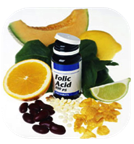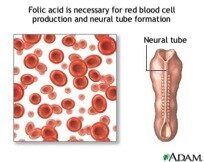
Folic Acid and Autism: Fact or Fiction.
The way folic acid prevents spinal closure and other physical defects is not understood, though there are several hypotheses. Recent theoretical evidence suggests it MAY be possible to avert some autism symptoms. There are reports of disruption of gene activity as probable cause for some forms of autism. Gamma Amino Butyric Acid (GABA) is involved in inhibitory nerve conduction in the central nervous system and plays a role during early embryonic development. Autism may involve defect of the GABA chemical receptor pathway in the brain. A recent study examined GABRB1 activity when nerve cells were supplemented with folic acid. GABA receptor gene protein levels increased in the Folic acid treated cells. These results suggest that control of gene expression may affect the expression of GABA receptor and disrupt inhibitory synaptic transmission during embryonic development. At this point, there is no proven connection with autism.

Wow! A nearly 30% reduction in risk of autism by taking Folic Acid. Pretty amazing. But wait a minute. Mothers in the study who used folic acid were of higher socioeconomic status and more health-conscious, according to the researchers. Researchers matched women for age but none of the other factors associated with autism, that are highly correlated with socioeconomic status, such as substance abuse, cigarette smoking or low birth weight. It turns out this could be critical because the result may mainly reflect socioeconomic status rather than Folic Acid. A study by Leavey, Zwaigenbaum and colleagues in Canada found lower socioeconomic status was associated with an increased risk of ASD. Another study by Rai and colleagues found in parental socioeconomic status was a risk factor for autism spectrum disorders in a Swedish population-based study. Premature birth and low birth weight are autism risk factors and are also associated with low socioeconomic status, which was not controlled for in this study.
Summary: While it appears prenatal and early postnatal folic acid supplements may reduce autism risk, at least in higher SES women, there are insufficient controls over critical factors in this study to know whether that is really true, or whether it just means that women with fewer health risks are less likely to have children with autism. We need a replication with a better matched control group. It also seems strange that Folic Acid only had effects on the more severely affected children, which needs to be examined more closely.
References
Leavey A, Zwaigenbaum L, Heavner K, Burstyn (2013) Gestational age at birth and risk of autism spectrum disorders in Alberta, Canada. J Pediatr. 162(2):361-8
Rai D, Lewis G, Lundberg M, Araya R, Svensson A, Dalman C, Carpenter P, Magnusson C. (2012) Parental socioeconomic status and risk of offspring autism spectrum disorders in a Swedish population-based study. Am Acad Child Adolesc Psychiatry. 51(5):467-476.e6
Surén P, Roth C, Bresnahan M, Haugen M, Hornig M, Hirtz D, Lie KK, Lipkin WI, Magnus P, Reichborn-Kjennerud T, Schjølberg S, Davey Smith G, Øyen AS, Susser E, Stoltenberg C. (2013) Association between maternal use of folic acid supplements and risk of autism spectrum disorders in children. JAMA. 13;309(6):570-7.
Vasquez K, Kuizon S, Junaid M, Idrissi AE. The Effect of Folic Acid on GABA(A)-B 1 Receptor Subunit. Adv Exp Med Biol.775:101-9.